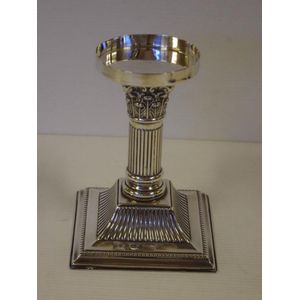Gilded Reticulated Comport in Paris Porcelain Manner
You must be a subscriber, and be logged in to view price and dealer details.
Subscribe Now to view actual auction price for this item
When you subscribe, you have the option of setting the currency in which to display prices to $Au, $US, $NZ or Stg.
- Comport - A comport is a type of decorative serving dish or bowl, typically used for desserts, fruits or other sweet treats. The comport is usually made from glass, silver or porcelain, which are materials known for their elegance and durability. They are often beautifully designed and decorated, and can be used as an elegant and decorative centerpiece for a table or dining room. They are also widely used as a decorative piece on the mantelpiece, sideboard, or other areas of the house.
- Navette - Navette, the French word for (weaver's) shuttle, means shuttle shaped, and is used to describe shapes in jewellery, ceramics and silver.
- Gilding - Gilding is a method of ornamentation whereby a thin sheet of gold metal is applied to items made of wood, leather, ceramics, glass and silver for decorative purposes.
For furniture including mirrors, the sheet of gold is usually applied over a coating of gesso. Gesso is a mixture of plaster of Paris and gypsum mixed with water and then applied to the carved wooden frames of mirrors and picture frames as a base for applying the gold leaf. After numerous coats of gesso have been applied, allowed to dry and then sanded a coat of "bole", a usually red coloured mixture of clay and glue is brushed on and allowed to dry, after which the gold leaf is applied. Over time parts of the gilding will rub off so the base colour can be seen. In water gilding, this was generally a blue colour, while in oil gilding, the under layer was often yellow. In Victorian times, gilders frequently used red as a pigment beneath the gold leaf.
Metal was often gilded by a process known as fire gilding. Gold mixed with mercury was applied and heated, causing the mercury to evaporate, the long-term effect of which was to kill or disable the craftsman or woman from mercury poisoning. The pursuit of beauty has claimed many victims, not the least of which were the artists who made those pieces so highly sought after today. - Socle - The short plinth, usually cylindrical, that serves as a pedestal for a sculpture or vase
This item has been included into following indexes:
Visually similar items

Leith Pottery (attributed), large and impressive neo-classical salt glazed garden urn, height 50 cm

Edwardian sterling silver centrepiece base, hallmarked Birmingham 1908 (J Sherwood & Sons), loaded, 16 cm high

Famille rose porcelain bowl on stand with gilt brass mounts, approx 20 cm high, 23 cm diameter (with stand)

A Victorian sterling silver goblet by George Unite, Birmingham 1868 with floral embossed and vacant cartouches and flute bowl 26 cm high, 515 grams
